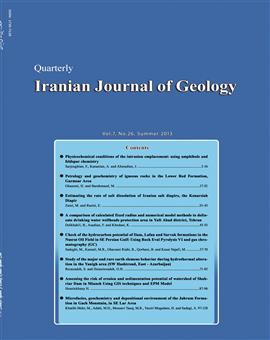Geochemistry, microfacies and depositional environment of Eocene Deposit in Gach Mountain, in SE Lar Area
Subject Areas :
1 -
Keywords: Geochemistry Microfacies Eocene Gach Mountian Zagros basin.,
Abstract :
The Jahrum Formation in Gach Mountain, located near village of Chahar Berkeh, in 30 Km of south- east of Lar City, south- west of Iran (Zagros Basin). This formation with the total thickness of 404.5 m consists of dolomite, calcareous dolomite and limestone. This formation overlies the Sachun Formation. The Asmari Formation with the total thickness of 44.5 m consists of limestone and marly limestone, and covered by evaporite deposits of the Gachsaran Formation. The age of the Jahrum Formation is Late Paleocene to Late Eocene. Eocene deposit in Gach Mountain, based on different facies, foraminifera and other skeletal and non skeletal grains, 7 microfacies were recognized. These microfacies deposited in a carbonates ramp environment with ooid shoal deposits. Analysis of 30 samples of limestones and dolomites for major and minor elements (Ca, Mg, Fe, Mn, Na, and Sr) and oxygen and carbon isotope values were used for carbonate mineralogy, types of dolomites, and diagenetic system. This study indicates that Jahrum carbonates were deposited in a shallow warm water tropical environment and original carbonate mineralogy was aragonite. These carbonates were affected by close to semi close diagenetic system with low water/rock interaction. Diagenetic trend in limestones and dolomite, based on oxygen and carbon isotope variations, shows a burial diagenesis with the presence of origanic matter. Temperature calculation based on heaviest oxygen isotope values (-3.32% PDB) of micrite and δw of Eocene seawater of - 0.85 SMOW, indicate that very shallow burial temperature was around 23˚C. Sequence stratigraphic studies, shows that two depositional sequences, consisting of transgrassive system tract (TST) and highstand system tract (HST). This sequences, shows third order type, with sequence boundaries (SB2). Maximum flooding surface in the Jahrum Formation was determined based on different facies and variation of isotope values.


